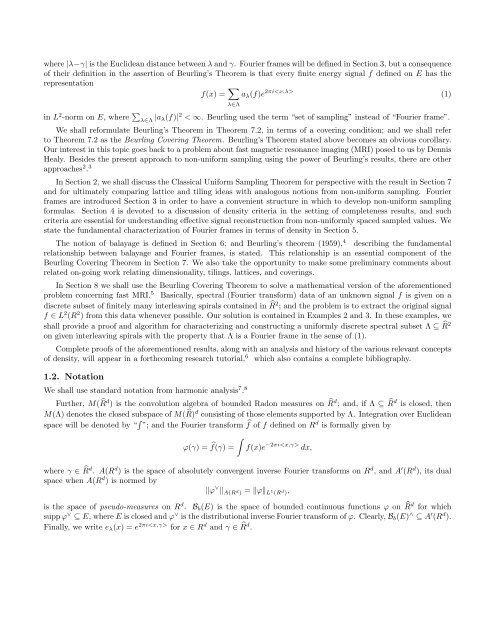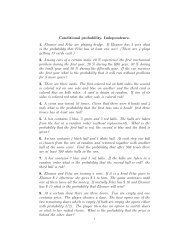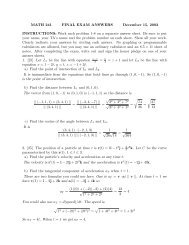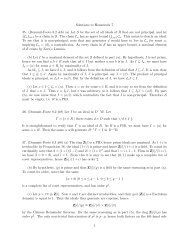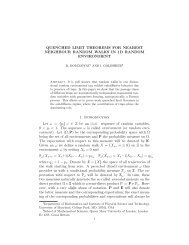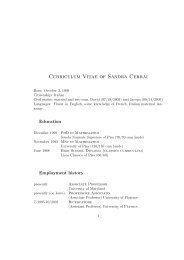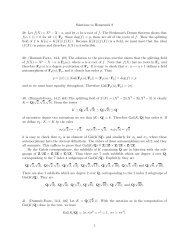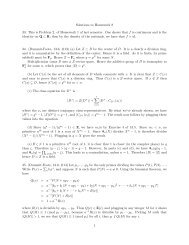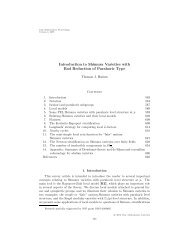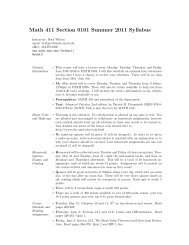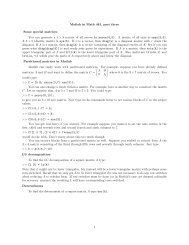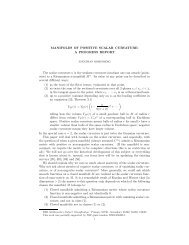Non-uniform sampling and spiral MRI reconstruction - Math ...
Non-uniform sampling and spiral MRI reconstruction - Math ...
Non-uniform sampling and spiral MRI reconstruction - Math ...
Create successful ePaper yourself
Turn your PDF publications into a flip-book with our unique Google optimized e-Paper software.
where |λ−γ| is the Euclidean distance between λ <strong>and</strong> γ. Fourier frames will be defined in Section 3, but a consequenceof their definition in the assertion of Beurling’s Theorem is that every finite energy signal f defined on E has therepresentationf(x) = ∑ λ∈Λa λ (f)e 2πi (1)in L 2 -norm on E, where ∑ λ∈Λ |a λ(f)| 2 < ∞. Beurling used the term “set of <strong>sampling</strong>” instead of “Fourier frame”.We shall reformulate Beurling’s Theorem in Theorem 7.2, in terms of a covering condition; <strong>and</strong> we shall referto Theorem 7.2 as the Beurling Covering Theorem. Beurling’s Theorem stated above becomes an obvious corollary.Our interest in this topic goes back to a problem about fast magnetic resonance imaging (<strong>MRI</strong>) posed to us by DennisHealy. Besides the present approach to non-<strong>uniform</strong> <strong>sampling</strong> using the power of Beurling’s results, there are otherapproaches 2 . 3In Section 2, we shall discuss the Classical Uniform Sampling Theorem for perspective with the result in Section 7<strong>and</strong> for ultimately comparing lattice <strong>and</strong> tiling ideas with analogous notions from non-<strong>uniform</strong> <strong>sampling</strong>. Fourierframes are introduced Section 3 in order to have a convenient structure in which to develop non-<strong>uniform</strong> <strong>sampling</strong>formulas. Section 4 is devoted to a discussion of density criteria in the setting of completeness results, <strong>and</strong> suchcriteria are essential for underst<strong>and</strong>ing effective signal <strong>reconstruction</strong> from non-<strong>uniform</strong>ly spaced sampled values. Westate the fundamental characterization of Fourier frames in terms of density in Section 5.The notion of balayage is defined in Section 6; <strong>and</strong> Beurling’s theorem (1959), 4 describing the fundamentalrelationship between balayage <strong>and</strong> Fourier frames, is stated. This relationship is an essential component of theBeurling Covering Theorem in Section 7. We also take the opportunity to make some preliminary comments aboutrelated on-going work relating dimensionality, tilings, lattices, <strong>and</strong> coverings.In Section 8 we shall use the Beurling Covering Theorem to solve a mathematical version of the aforementionedproblem concerning fast <strong>MRI</strong>. 5 Basically, spectral (Fourier transform) data of an unknown signal f is given on adiscrete subset of finitely many interleaving <strong>spiral</strong>s contained in ̂R 2 ; <strong>and</strong> the problem is to extract the original signalf ∈ L 2 (R 2 ) from this data whenever possible. Our solution is contained in Examples 2 <strong>and</strong> 3. In these examples, weshall provide a proof <strong>and</strong> algorithm for characterizing <strong>and</strong> constructing a <strong>uniform</strong>ly discrete spectral subset Λ ⊆ ̂R 2on given interleaving <strong>spiral</strong>s with the property that Λ is a Fourier frame in the sense of (1).Complete proofs of the aforementioned results, along with an analysis <strong>and</strong> history of the various relevant conceptsof density, will appear in a forthcoming research tutorial, 6 which also contains a complete bibliography.1.2. NotationWe shall use st<strong>and</strong>ard notation from harmonic analysis 7 . 8Further, M( ̂R d ) is the convolution algebra of bounded Radon measures on ̂R d ; <strong>and</strong>, if Λ ⊆ ̂R d is closed, thenM(Λ) denotes the closed subspace of M( ̂R) d consisting of those elements supported by Λ. Integration over Euclideanspace will be denoted by “ ∫ ”; <strong>and</strong> the Fourier transform ̂f of f defined on R d is formally given by∫ϕ(γ) = ̂f(γ) = f(x)e −2πi dx,where γ ∈ ̂R d . A(R d ) is the space of absolutely convergent inverse Fourier transforms on R d ,<strong>and</strong>A ′ (R d ), its dualspace when A(R d ) is normed by‖ϕ ∨ ‖ A(R d ) = ‖ϕ‖ L 1 (R d ),is the space of pseudo-measures on R d . B b (E) is the space of bounded continuous functions ϕ on ̂R d for whichsupp ϕ ∨ ⊆ E, where E is closed <strong>and</strong> ϕ ∨ is the distributional inverse Fourier transform of ϕ. Clearly, B b (E) ∧ ⊆ A ′ (R d ).Finally, we write e λ (x) =e 2πi for x ∈ R d <strong>and</strong> γ ∈ ̂R d .


